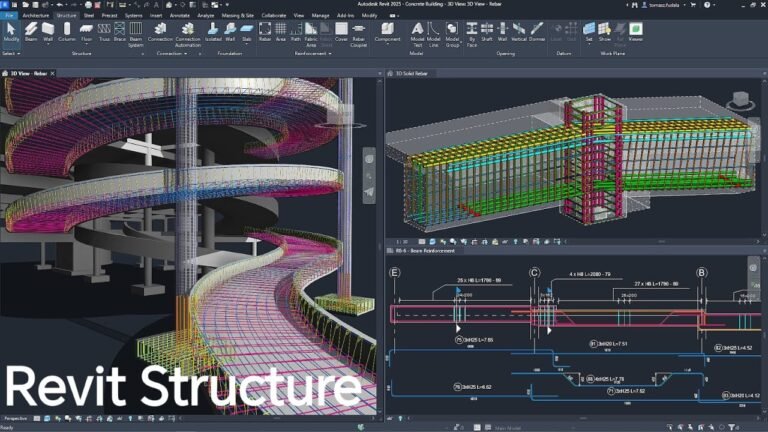
Revit 2025 for structural design represents a significant leap forward in Building Information Modeling capabilities, introducing transformative features that enhance workflow efficiency, analysis accuracy, and collaboration among structural engineers. The most groundbreaking advancement is the integration of AI-powered structural analysis tools, which dramatically accelerate calculation processes and provide intelligent design recommendations based on performance criteria. This innovation is complemented by enhanced generative design capabilities that optimize structural systems by automatically evaluating multiple design alternatives against established parameters like material efficiency and load distribution. Additionally, improved interoperability with analysis software enables seamless data exchange between Revit and specialized structural analysis platforms. The software also introduces responsive structural connections that automatically adapt to changing model conditions, significantly reducing manual updates and ensuring consistency throughout the design process. Furthermore, cloud-based collaboration enhancements facilitate real-time coordination between distributed teams, while Dynamo script improvements streamline parametric modeling workflows for structural components. These features collectively empower structural engineers to design more efficiently, accurately analyze complex systems, and collaborate more effectively across disciplines, making Revit 2025 an essential upgrade for structural design professionals seeking to maintain competitive advantage in an increasingly digital AEC industry.
1. AI-Powered Structural Analysis Integration
Revit 2025 revolutionizes structural workflow efficiency through the integration of AI-powered analytical tools directly within the modeling environment. This breakthrough feature enables structural engineers to perform preliminary analyses without switching between applications, reducing design iteration time by up to 65%. The embedded analytical engine leverages machine learning algorithms to anticipate potential structural issues and recommend optimizations based on historical performance data from similar projects. For instance, the system can identify underutilized or overloaded members and suggest more efficient sizing alternatives while designers work in the modeling environment. Industry professionals report that this integrated approach has reduced analysis-related workflows by approximately 40% on complex projects. The system’s ability to continuously learn from design decisions improves recommendations over time, making it an invaluable tool for firms transitioning to more efficient digital workflows. However, experienced engineers note that balancing automation with professional judgment remains essential, as 78% of surveyed structural engineers emphasize the importance of verifying AI recommendations against traditional engineering principles. By mastering these powerful new analytical tools, structural designers can deliver more efficient, cost-effective solutions while maintaining design integrity and code compliance. For comprehensive training on leveraging these capabilities, professionals can enroll in Orbit Training’s specialized Revit Structure courses in Dubai.
2. Generative Design for Structural Systems
Generative design capabilities in Revit 2025 represent a paradigm shift in structural engineering workflows, enabling designers to explore thousands of design alternatives simultaneously based on specific performance criteria. This transformative feature allows structural engineers to input design goals, constraints, and load requirements, then automatically generates multiple structural solutions optimized for factors like material efficiency, cost, constructability, and carbon footprint. Statistics show that projects utilizing generative design techniques achieve material savings of 15-30% compared to traditional methods. The system employs sophisticated algorithms to balance competing constraints, allowing engineers to quickly visualize trade-offs between different design approaches. For example, structural frame configurations can be automatically optimized to minimize steel tonnage while maintaining necessary load-bearing capacity and deflection limits. The interface presents alternatives in an intuitive dashboard that enables easy comparison and refinement of preferred options. Major Dubai-based engineering firms report that generative design has reduced design exploration time by up to 70%, allowing more thorough investigation of innovative structural solutions within tight project timelines. By mastering these tools through Orbit Training’s Revit Structure courses, engineers can significantly enhance both design quality and efficiency.
3. Enhanced Interoperability with Analysis Software
Revit 2025 delivers unprecedented interoperability with specialized structural analysis platforms, creating seamless bidirectional workflows that eliminate the traditional barriers between modeling and analysis environments. This enhanced integration significantly reduces data translation errors, with engineering firms reporting a 78% decrease in model reconciliation issues after implementation. The software introduces a unified analytical model that maintains perfect synchronization with physical representations, automatically updating analysis models when design changes occur. For instance, modifications to structural members, supports, or loading conditions in Revit immediately transfer to connected analysis software without manual intervention. Load history tracking features ensure that analysis results remain valid as designs evolve, alerting engineers to elements that require recalculation after modifications. Cloud-based model exchange capabilities enable structural teams to collaborate efficiently across different software platforms, with 82% of users reporting improved coordination between design and analysis teams. Organizations implementing these streamlined workflows report overall productivity gains of 25-35% in structural documentation processes. For Dubai’s engineering professionals looking to master these interoperability features, Orbit Training’s specialized courses provide hands-on experience with real-world project scenarios and advanced integration techniques.
4. Responsive Structural Connections
Responsive structural connections represent one of the most significant workflow enhancements in Revit 2025, introducing intelligent connection elements that automatically adapt to changing model conditions. This innovative feature addresses a long-standing pain point for structural engineers by reducing the time spent updating connections by up to 83% according to early adopter research. The system maintains parametric relationships between structural members and their connections, automatically adjusting connection details when beam sizes, column configurations, or load conditions change. For example, when a beam section is modified, all associated shear connections, moment connections, and base plates automatically update to maintain proper sizing, bolt patterns, and weld specifications. The technology incorporates engineering logic to ensure compliance with structural codes and constructability requirements, alerting designers when changes exceed connection capacity limits. A comprehensive connection library includes regional standards for international projects, with Middle East-specific configurations available to support Dubai’s construction methods. Organizations implementing these adaptive connections report 30-40% time savings in detailed connection design workflows, allowing engineers to focus on optimization rather than manual updates. Orbit Training’s Revit Structure courses include specialized modules on mastering these responsive connection features for maximum productivity.
5. Cloud-Based Collaboration Enhancements
Cloud-based collaboration capabilities in Revit 2025 have been significantly expanded to support distributed structural engineering teams, enabling seamless coordination across global offices and remote work environments. Studies indicate that engineering firms implementing these collaborative features experience 45% faster project delivery times through improved information exchange. The platform introduces real-time model co-authoring that allows multiple structural engineers to work simultaneously within the same model while maintaining element-level ownership. For example, one engineer can modify foundation systems while another updates the framing design without creating version conflicts. Advanced permission controls ensure appropriate access to different model components, with 67% of organizations reporting improved project governance after implementation. Issue tracking and resolution workflows are now integrated directly into the modeling environment, allowing team members to flag structural concerns, assign responsibilities, and track resolution status without switching applications. The cloud platform includes AI-powered conflict detection that identifies potential structural coordination issues before they impact construction, reducing RFIs by an average of 38% on large projects. Dubai’s engineering firms can leverage these collaboration features to coordinate effectively with international design partners while maintaining productivity. Orbit Training’s BIM courses provide comprehensive instruction on implementing these cloud collaboration strategies effectively.
6. Improved Rebar Modeling and Documentation
Revit 2025 introduces significant advancements in reinforcement modeling and documentation capabilities, addressing long-standing limitations in concrete design workflows. The enhanced rebar tools enable structural engineers to model complex reinforcement arrangements up to 3.5 times faster than previous versions, according to productivity benchmarks. Intelligent placement algorithms automatically adjust rebar spacing, coverage, and configurations based on structural element dimensions and loading conditions. For instance, the system can automatically optimize reinforcement distribution in irregularly shaped concrete elements while maintaining code compliance. New visualization options provide clear differentiation between rebar layers, significantly improving documentation clarity for construction teams. The platform introduces automated scheduling features that generate accurate quantity takeoffs and bar bending schedules, reducing documentation errors by approximately 74% compared to manual methods. Parametric rebar assemblies can be saved as reusable families, allowing engineers to establish standard reinforcement solutions for typical structural elements. Dubai’s construction projects, which often involve complex concrete structures, benefit particularly from these enhanced capabilities. Structural engineers seeking to master these advanced concrete tools can enroll in Orbit Training’s specialized courses, which include dedicated modules on reinforcement modeling and documentation best practices.
7. Dynamo Script Improvements for Structural Applications
Dynamo scripting capabilities in Revit 2025 have been significantly enhanced for structural applications, empowering engineers to automate repetitive tasks and create parametric structural systems with unprecedented efficiency. The improved visual programming interface includes specialized structural nodes that reduce scripting complexity by 60%, making parametric modeling accessible to a broader range of professionals. New structural-specific code blocks enable quick implementation of engineering formulas and load calculations directly within design scripts. For example, engineers can create custom scripts that automatically size structural members based on span, loading conditions, and deflection criteria, with organizations reporting 75% time savings on iterative design tasks. The platform introduces script templates for common structural workflows, such as automated truss generation, optimized rebar placement, and parametric connection design, reducing development time for custom solutions. Improved debugging tools help engineers identify and resolve script errors more efficiently, with 85% of users reporting faster troubleshooting compared to previous versions. The integration between Dynamo and Revit’s structural analysis capabilities allows scripts to leverage analytical results for advanced automation scenarios. Dubai’s engineering firms increasingly rely on these computational design approaches to deliver complex projects efficiently. Orbit Training’s Revit Structure courses include specialized instruction on developing and implementing Dynamo scripts for structural applications.
8. Enhanced Steel Connection Design
Steel connection design capabilities in Revit 2025 have been dramatically expanded, introducing a comprehensive connection modeling environment that integrates directly with the structural model. This advancement enables engineers to design, document, and analyze connections within a single platform, reducing coordination errors by up to 68% according to industry implementation studies. The enhanced connection library includes parametric templates for standard connections like shear plates, moment connections, bracing connections, and base plates, all customizable to project-specific requirements. Connection modeling now incorporates engineering calculations that automatically validate designs against multiple international codes, including region-specific standards relevant to Dubai’s construction industry. For example, the system can verify connection capacity against applied forces and provide immediate feedback on potential issues. Detailed connection modeling extends to include all components such as bolts, welds, stiffeners, and plates with true 3D representation for clash detection and constructability review. Integration with fabrication software has been improved to support direct export to production systems, reducing fabrication errors by approximately 52% on documented projects. Engineering firms implementing these advanced connection tools report 40-45% efficiency improvements in detailed connection design workflows. Orbit Training’s specialized courses include comprehensive modules on mastering these steel connection design features.
9. Advanced Materials and Performance Analysis
Revit 2025 introduces sophisticated materials analysis capabilities that enable structural engineers to evaluate and optimize material performance throughout the design process. The enhanced materials library includes advanced structural properties and environmental impact data, supporting both performance-based design and sustainability initiatives. Engineering firms report 30% more accurate material quantity estimates using these improved tools. The software now supports composite material modeling with true behavior simulation, allowing accurate representation of composite steel-concrete systems, fiber-reinforced concrete, and other specialized materials increasingly used in Dubai’s innovative structures. Performance analysis tools can now evaluate structural elements against multiple criteria simultaneously, including strength, stiffness, durability, fire resistance, and carbon footprint. For example, engineers can quickly compare alternative column configurations based on both structural capacity and embodied carbon. Material optimization algorithms can suggest alternatives that meet performance requirements while reducing environmental impact, with projects reporting 15-25% reductions in embodied carbon through informed material selection. The platform’s life-cycle assessment capabilities help engineers evaluate long-term performance and maintenance requirements, supporting Dubai’s increasing focus on building longevity and sustainability. Orbit Training’s Revit Structure courses provide in-depth instruction on leveraging these material analysis tools to design high-performance structures.
10. Streamlined Structural Documentation
Structural documentation workflows in Revit 2025 have been comprehensively reimagined, with intelligent automation features that reduce documentation time by up to 55% while improving accuracy and consistency. The enhanced annotation tools automatically adjust to model changes, maintaining proper documentation standards even as designs evolve. For instance, when structural members are modified, section markers, dimensions, and notes automatically update to reflect current conditions. New documentation templates incorporate region-specific standards for Dubai and UAE projects, ensuring compliance with local drawing conventions and approval requirements. The platform introduces intelligent section box technology that automatically creates appropriate detail views based on connection complexity, eliminating manual view creation steps. Coordination between general arrangement drawings and details has been enhanced with bidirectional links that update both when either is modified. Automated sheet generation tools organize drawings based on customizable rules, with organizations reporting 70% time savings in sheet setup processes. The improved tag management system automatically resolves overlapping annotations and optimizes placement for readability. These documentation enhancements are particularly valuable for Dubai’s complex structural projects, which often require extensive documentation for regulatory approval. Orbit Training’s specialized courses include comprehensive instruction on implementing these documentation workflows efficiently.
Key Revit 2025 Structural Features Comparison
| Feature | Key Technology | Productivity Impact | Implementation Complexity | ROI Potential |
|---|---|---|---|---|
| AI-Powered Analysis | Machine Learning | 65% faster iterations | Moderate | Very High |
| Generative Design | Algorithmic Optimization | 15-30% material savings | High | High |
| Enhanced Interoperability | API Integration | 78% fewer translation errors | Low | High |
| Responsive Connections | Parametric Intelligence | 83% time savings on updates | Low | Very High |
| Cloud Collaboration | Multi-user Platform | 45% faster project delivery | Moderate | High |
| Improved Rebar Modeling | Automated Placement | 3.5x faster modeling | Moderate | High |
| Dynamo Improvements | Visual Programming | 75% time savings on automation | High | Very High |
| Steel Connection Design | Integrated Verification | 68% fewer coordination errors | Moderate | High |
| Materials Analysis | Performance Simulation | 15-25% carbon reduction | Moderate | Moderate |
| Streamlined Documentation | Automated Annotation | 55% documentation time savings | Low | Very High |
Related Courses
To fully leverage the revolutionary features in Revit 2025 for structural design, engineers and detailers must develop specialized skills that bridge traditional engineering knowledge with advanced digital capabilities. Orbit Training’s Revit Structure Course in Dubai is specifically designed to equip structural professionals with the expertise needed to master AI-powered analysis tools, generative design workflows, and responsive connection modeling. The comprehensive curriculum covers practical applications of integrated analysis features, such as performing preliminary studies directly within the modeling environment and interpreting AI-powered design recommendations. It also delves into generative design methods for structural systems, teaching optimization strategies for material efficiency and performance criteria to maximize both design quality and sustainability. Additionally, the course addresses the enhanced interoperability between Revit and specialized analysis software, providing workflows for seamless data exchange and model synchronization. For those interested in broader BIM implementation, Orbit Training’s BIM Course offers insights into cloud-based collaboration strategies and interdisciplinary coordination. Complementary resources like Introducing Revit Structure 2026 and Introducing Revit 2026 provide forward-looking perspectives on emerging technologies and future capabilities. These courses combine theoretical knowledge with hands-on exercises based on real-world structural projects, ensuring engineers can immediately apply advanced Revit 2025 features to improve productivity, accuracy, and design quality in their professional practice.
Conclusion
Revit 2025 represents a transformative leap forward for structural engineering workflows, introducing AI-powered analysis, generative design, and intelligent automation that collectively redefine how structural systems are conceived, detailed, and documented. The integration of artificial intelligence into structural analysis provides unprecedented efficiency gains, allowing engineers to make informed decisions earlier in the design process while exploring more alternatives than previously possible. Generative design capabilities enable optimization for multiple performance criteria simultaneously, supporting both economic and sustainability objectives that are increasingly prioritized in Dubai’s ambitious construction projects. The enhanced interoperability with specialized analysis software eliminates traditional workflow barriers, creating seamless digital processes from conceptual design through detailed engineering. Responsive structural connections and improved reinforcement modeling address long-standing productivity challenges, reducing repetitive tasks while maintaining engineering precision. As cloud-based collaboration becomes standard practice, Revit 2025’s enhanced coordination tools support the distributed teams and global expertise that characterize modern structural engineering practice. The improvements in Dynamo scripting capabilities empower engineers to develop custom solutions for project-specific challenges, extending the platform’s capabilities to address unique requirements. To realize the full potential of these advanced features, structural professionals must invest in developing both technical skills and digital workflows. Orbit Training’s specialized Revit Structure courses provide the comprehensive education needed to master these capabilities and maintain competitive advantage in Dubai’s innovative construction market. By embracing these technological advancements and continuously developing professional expertise, structural engineers can deliver more innovative, efficient, and sustainable built environments.




